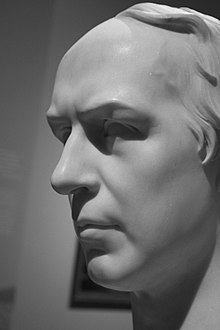
Summary
Allan Cunningham (7 December 1784 – 30 October 1842) was a Scottish poet and author.


Life edit
He was born at Keir, near Dalswinton, Dumfries and Galloway, and first worked as a stonemason's apprentice. His father was a neighbour of Robert Burns at Ellisland, and Allan with his brother James visited James Hogg, the "Ettrick shepherd", who became a friend to both.[1] Cunningham's other brothers were the naval surgeon Peter Miller Cunningham (1789–1864) and the poet, Thomas Mounsey Cunningham (1776–1834).
Cunningham gave his leisure to reading and writing imitations of old Scottish ballads. In 1809 he collected old ballads for Robert Hartley Cromek's Remains of Nithsdale and Galloway Song; he sent in, however, poems of his own, which the editor inserted, even though he may have suspected their real authorship.[1] It gained for him the friendship of Walter Scott and James Hogg.
In 1810 Cunningham went to London, where he worked as a parliamentary reporter and journalist until 1814, when he became clerk of the works in the studio of the sculptor, Francis Chantrey, a post he kept until Chantrey's death in 1841.[1]
Works edit
Cunningham contributed some songs to Eugenius Roche's Literary Recreations in 1807. He wrote three novels, a life of Sir David Wilkie,[2] and Lives of Eminent British Painters, Sculptors, and Architects (1829–33),[3][4] that include biographies of William Hogarth, Sir Joshua Reynolds, Thomas Gainsborough and William Blake.[5]
Besides these, he wrote many songs. A Wet Sheet and a Flowing Sea is a sea-song; and many other of Cunningham's songs became popular. He also brought out an edition of Robert Burns' Works.
Other works included:
- Sir Marmaduke Maxwell (1820) (play)
- The King of the Peak (1822), the story of Sir George Vernon and his daughter, Dorothy Vernon's supposed elopement with John Manners from Haddon Hall.
- The Maid of Elvar (1830) (a poem, in twelve parts)
- The Life and Correspondence of Robert Burns (1836)
- The Poems, Letters and Land of Robert Burns (1838), a new memoir of the poet and notices critical and biographical of his works
Family edit
Cunningham was married to Jean Walker, who had been servant in a house where he lived, and they had five sons and one daughter,[1] all of whom rose to important positions, and inherited in some degree his literary gifts. Among them were Joseph Davey Cunningham, Alexander Cunningham, Peter Cunningham and Francis Cunningham.
See also edit
References edit
Cited sources
- ^ a b c d One or more of the preceding sentences incorporates text from a publication now in the public domain: Chisholm, Hugh, ed. (1911). "Cunningham, Allan". Encyclopædia Britannica. Vol. 7 (11th ed.). Cambridge University Press. p. 633.
- ^ "Review of The Life of Sir David Wilkie, R.A. by Allan Cunningham". The Quarterly Review. 72: 397–452. September 1843.
- ^ "Review of Lives of the most Eminent British Painters, Sculptors, and Architects by Allan Cunningham, in 6 vols., 1830–1833". The Quarterly Review. 50: 56–88. October 1833.
- ^ "Review of Lives of the British Architects by Allan Cunningham, 1831; and Designs for Parsonages and Farm Houses, &c. by E. F. Hunt, 1828; and Exemplars of Tudor Architecture by E. F. Hunt, 1830". The Quarterly Review. 45: 471–504. July 1831.
- ^ Cunningham, Allan (1833). The lives of the most eminent British painters and sculptors. New York: J. & J. Harper; 5 vols.; vol. 1 publ. 1846; vols. 2–5 publ. 1835. (See vol. 1 for Hogarth, Reynolds, & Gainsborough; vol. 2 for Blake.)
Further reading
- This article incorporates text from a publication now in the public domain: Cousin, John William (1910). A Short Biographical Dictionary of English Literature. London: J. M. Dent & Sons – via Wikisource.
External links edit
Allan Cunningham
- Works by Allan Cunningham at Project Gutenberg
- Works by or about Allan Cunningham at Internet Archive
- Works by Allan Cunningham at LibriVox (public domain audiobooks)
- Works by Allan Cunningham at Open Library
- "Archival material relating to Allan Cunningham". UK National Archives.


